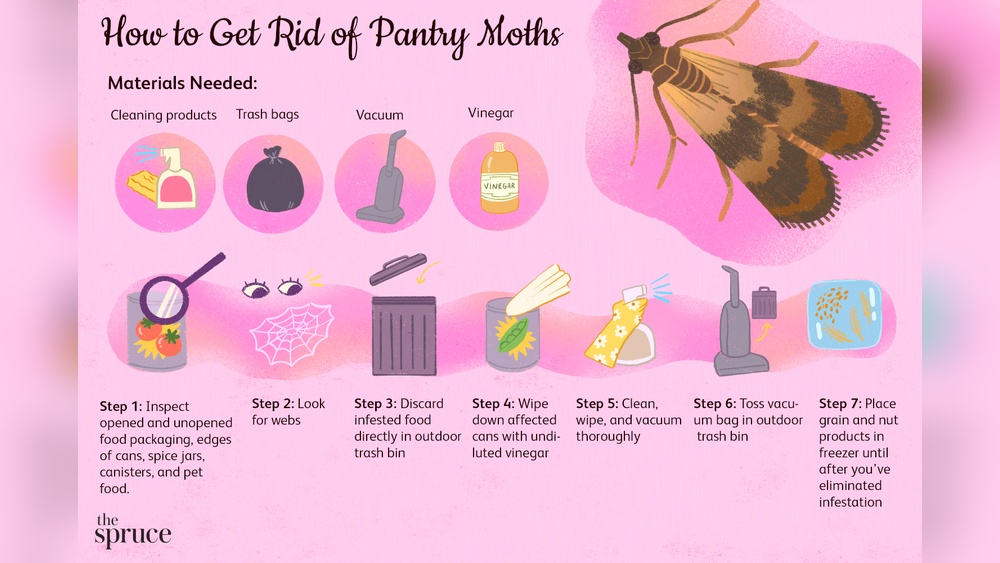Are you noticing tiny moths fluttering around your kitchen shelves? Those pesky pantry moths can quickly turn your food storage into a frustrating mess.
If you’ve caught yourself wondering how to get rid of moths in the kitchen, you’re not alone—and the good news is, you can take control. These moths sneak in through contaminated food or open windows, and once they settle, they love to feast on your flour, cereal, pasta, and spices.
But don’t worry—you don’t have to live with them. Keep reading to discover simple, effective steps you can take right now to eliminate these unwelcome guests and protect your kitchen from future invasions. Your pantry deserves to be moth-free, and we’re here to help you make that happen.
Pantry Moth Origins
Pantry moths often enter kitchens through infested dry foods. These include flour, cereal, pasta, and spices. Moths lay eggs inside these foods, which hatch and cause infestation.
Open doors, windows, vents, and small gaps are common entry points. Moths easily fly inside through these openings. They seek out dry goods to lay eggs on.
| Common Entry Points | Attracted Food Types |
|---|---|
| Open doors and windows | Flour, cereal, pasta |
| Gaps around vents and cables | Spices, grains |
| Contaminated food packages | Dry goods stored in pantries |

Spotting Infestations
Small white larvae often hide inside dry goods like flour and cereal. These larvae leave behind silky webs that look like cobwebs. You might see clumps of sticky silk inside packages or cupboards. Sometimes, you notice holes or clumps in grains or pasta. Moth eggs are tiny and hard to spot but their presence shows with webs and larvae. Check every corner of your pantry carefully. Look inside bags, boxes, and containers. Webs can also stick to the shelf surfaces or walls. Finding these signs early helps stop the infestation from growing. Clean out the pantry and throw away any food with webs or larvae. Keep food in sealed containers to prevent moths from returning.
Removing Infested Items
Check all food packages carefully for holes or damage. Moths often lay eggs inside bags of flour, cereal, pasta, or spices. Any sign of webbing, clumping, or small bugs means the food is infested. Remove these items immediately to stop the moths from spreading.
Use safe disposal methods to throw away infested food. Seal the items tightly in a plastic bag before tossing them in the trash. This keeps moths from escaping and laying eggs elsewhere. Avoid simply dumping food in the compost or leaving it outside where moths can return.
After discarding, clean the shelves and pantry with soap and water. Wipe down all corners and cracks where eggs or larvae might hide. This helps to prevent future infestations and keeps the kitchen clean and safe.
Deep Cleaning Kitchen Areas
Start by removing everything from shelves and cabinets. Use a damp cloth with mild soap to wipe all surfaces. Pay close attention to corners and crevices where moths and larvae hide. Dispose of crumbs and food residue immediately to prevent attracting moths again.
Vacuum shelves, corners, and cabinet floors thoroughly. This removes eggs, larvae, and small debris. After vacuuming, clean the vacuum bag or canister outside to avoid spreading moths back indoors. Use a brush attachment to reach tight spots.
Preventing Future Moth Problems
Store food in airtight containers to keep moths out. Use glass jars or plastic containers with tight lids. This stops moths from reaching grains, flour, and cereals.
Check all food packages before bringing them home. Throw away any with holes or tears.
Seal entry points like cracks, gaps, and vents around doors and windows. Use weather stripping or caulk to close these openings. This blocks moths from flying into the kitchen.
Keep doors and windows closed or screened. This reduces chances of moths entering your home.

Using Traps And Natural Deterrents
Sticky traps catch moths by luring them with a scent. Place traps near pantry shelves, corners, and dark spots. Check traps weekly and replace when full. They help reduce moth numbers quickly.
Herbs like bay leaves, lavender, and rosemary keep moths away naturally. Use dried herbs in small cloth bags and place them in cupboards. Essential oils such as peppermint, eucalyptus, and citronella work well too. Dab a few drops on cotton balls and set them near food storage areas. These oils create a smell moths dislike.
Maintaining A Moth-free Kitchen
Check your pantry at least once a week to spot any infested food items. Look carefully at bags of flour, cereal, pasta, and spices. Use a flashlight to see inside dark shelves. Remove any food showing signs of moths or larvae immediately. This stops moths from spreading further.
Rotate your food supplies often. Use older items first before opening new packages. This helps keep food fresh and reduces chances for moths to grow. Store all dry goods in airtight containers to block moth access.
| Step | Action |
|---|---|
| Inspect | Look for moths and larvae weekly in the pantry. |
| Discard | Throw away any infested food right away. |
| Rotate | Use older food before opening new packages. |
| Store | Keep food in airtight containers to prevent moths. |

Frequently Asked Questions
Why Do I Have Moths In My Kitchen?
Moths appear in kitchens due to infested dry foods like flour, cereal, or spices. They enter through contaminated products or open doors and windows. Store food in airtight containers, discard infested items, and clean pantry shelves to prevent moth infestations effectively.
What Is The Fastest Way To Get Rid Of Moths?
The fastest way to get rid of moths is to discard infested food, clean pantry shelves thoroughly, and use airtight containers. Place sticky traps to catch remaining moths and prevent re-infestation.
How Do I Get Rid Of A Moth Infestation In My Kitchen?
Identify and discard infested food items immediately. Clean pantry shelves thoroughly. Store dry goods in airtight containers. Use sticky moth traps to monitor and catch moths. Seal entry points like gaps around doors and windows to prevent re-infestation.
How Do You Get Rid Of Moths When You Can’t Find The Source?
Set sticky traps to catch moths and clean pantry shelves thoroughly. Store food in airtight containers. Regularly inspect all dry goods and discard any suspicious items. Keep kitchen sealed to block moth entry points. Repeat cleaning until moth activity stops.
Conclusion
Getting rid of moths in the kitchen takes patience and care. Start by removing all infested food items without delay. Clean shelves and cupboards well to eliminate eggs and larvae. Store all dry goods in airtight containers to prevent future problems.
Keep doors and windows closed or use screens to block moth entry. Regular checks help catch any new moth activity early. Taking these simple steps keeps your kitchen moth-free and your food safe. Stay consistent, and your kitchen will stay clean and pest-free.

